Pottering about Pai, Mae Hong Song
Many twists to the Batcave
My neighbour’s nickname is “Pai”. The Thai verb “to go” is also “pai”, and the pretty little town north of Chiang Mai, in Mae Hong Son province, is now named “Pai”. So if my neighbour were to travel to this scenic location, the Thai phrase would be Pai pai Pai … with, perhaps, different Thai letters used in the spelling of the three words, and perhaps also with different tone markers … but Pai pai Pai just the same.
I guess “Pai Pai Pai” could be shorthand for the mathematician’s dilemma of ∏ ∏ ∏ … or a gourmand’s dream of multiple desserts of pie pie pie … but this is about a journey with many twists and turns.
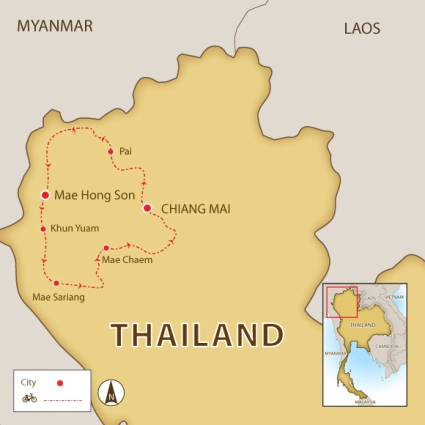 The road north from Chiang Mai is dual carriageway most of the way to the Pai turn off, so it is easy to zip along at 100 kmh. However, once that fateful turn to the west is made just before the market town of Mae Tang, the going gets tough and twisty. I had Google maps showing on my telephone, and watching the twists (all 762 of them) and turns and switchbacks and double dog’s legs and loop-the-loops slowly slither along, I proved that I was at least as tough as the going was, and forced my little car up and down and around as if we were travelling on some super Coney Island big dipper.
The road north from Chiang Mai is dual carriageway most of the way to the Pai turn off, so it is easy to zip along at 100 kmh. However, once that fateful turn to the west is made just before the market town of Mae Tang, the going gets tough and twisty. I had Google maps showing on my telephone, and watching the twists (all 762 of them) and turns and switchbacks and double dog’s legs and loop-the-loops slowly slither along, I proved that I was at least as tough as the going was, and forced my little car up and down and around as if we were travelling on some super Coney Island big dipper.
The journey is only a bit over 120 kilometres, but with all those turns and with a climb up to about 1200 metres from Chiang Mai’s 300m above sea level, and down again, and with slooow traffic holding up the Speedy Gonzales of the motoring world, it is about a two and a half hour drive.
Pai was settled by the Dai and the Shan who escaped from wars in nearby Myanmar or Burma. The Dai word “pai” means to escape. Others say that the town was known as “Plai” after the male elephants (“plai”) sent as tribute to the Kingdom of Ayutthaya (1300s – 1700s) in what is now central Thailand. Whatever its sources, Pai now just means “party town”.
Pai has a permanent population of just over two thousand who tend to the hordes of visitors who come seeking a cool experience – winters in Pai are very chilly – or a “cool” experience as the town has long been a favourite destination for travellers seeking an alternate life-style.
Unlike Chiang Mai where I live amid invading hordes of Chinese, the laid-back souls in Pai are mainly European or Northern American – dreadlocks and tattoos and piercings and multiple bracelets and anklets are not compulsory … but pretty abundant.
Vibrant street scenes

Pai street art
The busy little streets are full of travel agencies and tour agencies, tacky souvenir shops, clothing shops selling sloppy fisherman’s pants in wild elephant or geometric prints, identical “I survived the 762 turns to Pai” T-shirts, coffee shops, bars, restaurants, tattoo parlours and massage places. My favourite was Siam Books, a great used and new bookshop in Pai Walking Street. I did not see any art galleries, although there is one hotel called the Phu Pai Art Resort but I did not visit it.
Walking Street gets going in the late afternoons as tables and mini-kitchens slowly invade the footpaths and then take over the roads, with traffic dwindling to a trickle and then to no cars at all – just pedestrians weaving from one stall to another, eating, chatting, smoking, drinking … and buying fisherman’s pants.
Despite all this – or because of it – I am not sure – Pai is really a charming, slow, comfortable place. There is accommodation of all sorts and at all prices including the women-only “Hostelle”, the infamous Pai Circus Hostel (which I visited hoping to see fire-eating, tumblers, acrobats or clowns but saw nothing but the tumblers of Chang beer on the tables) and then there is the Reverie Siam with its lovely Mediterranean-flavoured Silhouette restaurant.
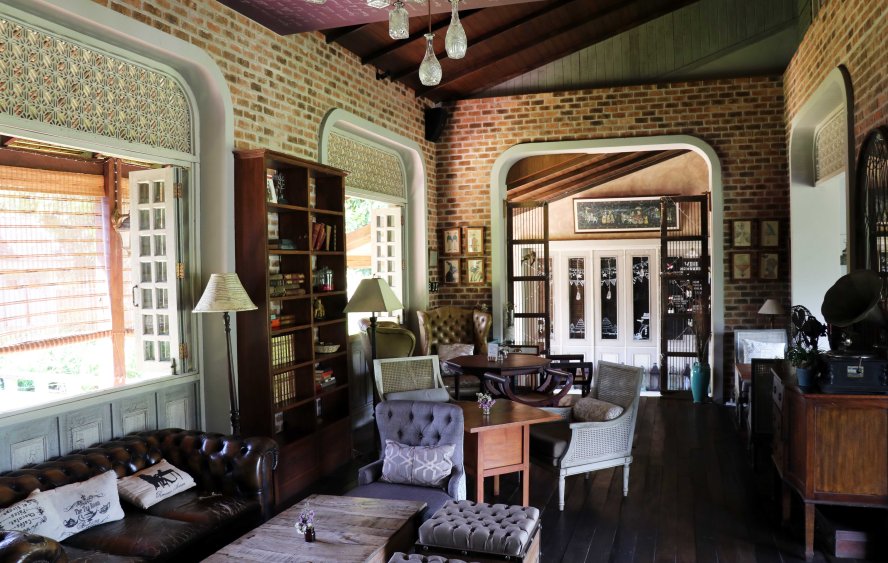
Silhouette Restaurant, Reverie Siam
I spent a few very comfortable nights at the Reverie Siam on my last visit to Pai about four years ago but this time I was there only for a slow lunch of Tasmanian smoked salmon wraps and a yummo and crunchy caramelised-topped crème caramel. The restaurant – like the whole resort – draws its design inspirations from an imagined 1920s colonial heritage. The presence of a small boy who was violently ill added a new note to the doubly atmospheric drawing room adjacent to the restaurant … with people scrabbling to find new tables out of the sightline of the poor kid’s mishap.
Nights in Pai are very cold during the few weeks of Northern Thailand’s winter. Heavy duvets are necessary, and early-morning swims are discouraged by the very crisp 160C dawn temperatures. Most days there are heavy mists that are eventually burned off by the morning sun at about 10.30.
It is easy to spend a few days pottering around Pai and the many restaurants and bars on the River Pai, with a rickety old bamboo pedestrian bridge that links one part of the town with the other bank, but escaping Pai is also fun.
I stayed at Bura Lumpai Resort adjacent to the Memorial Bridge and about nine kilometres from the town centre. The resort had lots of one- or two-storeyed bungalows offering generously sized rooms scattered through pretty gardens and lakes by the Pai River. There was a nice swimming pool, a coffee shop and restaurant … and two nice dogs and one old bitch who yapped in the early hours every morning.
- There was a dog that also annoyed me …
Over the road and at both ends of the bridge are many small market stalls selling more T-shirts, fisherman’s pants, bottled water and stickers and postcards proclaiming, “I survived the 762 turns to Pai”.

Memorial Bridge with a “Japanese” soldier and a man with a Mauser
The Memorial Bridge today is at least the third iterance. There was originally a timber bridge built by invading Japanese soldiers during WWII and destroyed by them in their hasty retreat. A new one was built after their departure, but this time not created at the end of a bayonet. There was an ironic photo opportunity one day of a young man – who was probably Thai but certainly looked Japanese – in full Japanese military uniform with sword posing for photos with visitors at the end of the bridge. The second bridge was subsequently washed away in a flood.
According to some people the current iron bridge was relocated from Chiang Mai, which has an almost identical steel bridge. Perhaps the most likely story is that both the Pai steel bridge and the one in Chiang Mai were made from “bridge kits” the Japanese army brought in to facilitate the easy construction of river crossings for their troops … and then abandoned in their retreat. A modern concrete bridge for today’s traffic has been erected beside the old steel Memorial Bridge.
Hard-boiled eggs and sautéed swimmers
Just a couple of kilometres away from the bridge are the lovely Tha Pai Hot Springs. An unfortunate dual entry fee system applies here – as it does elsewhere in Thailand – where the charge is THB 300 (about US$10.00) for foreigners but only THB 50 for Thais. At a couple of such places I have tried speaking Thai and showing my Thai driving license to get the cheaper rate – but with limited success.
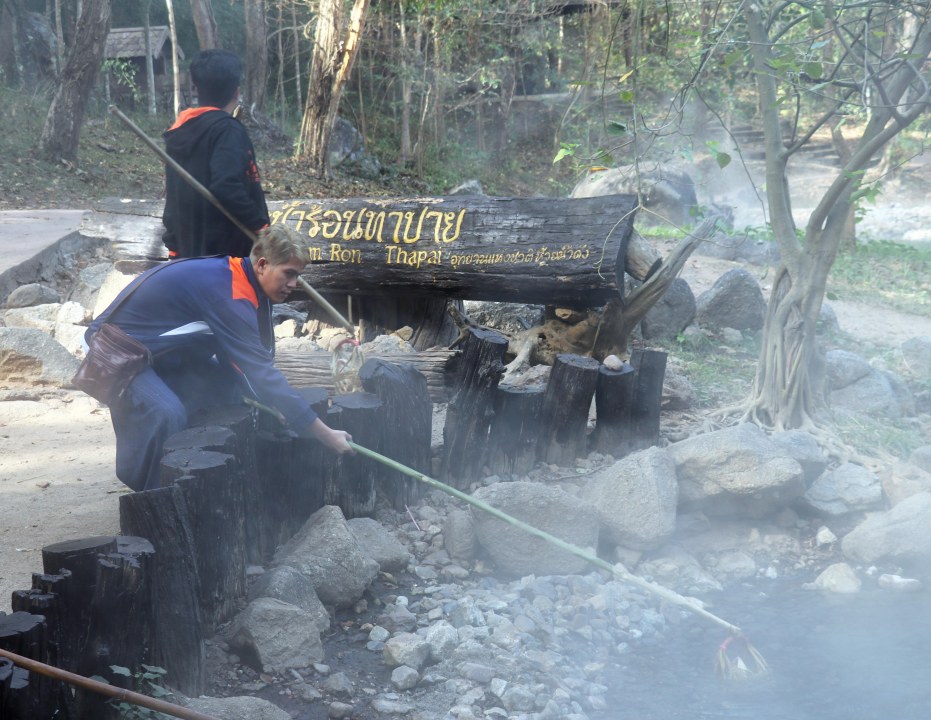
Boiling eggs in bamboo baskets
At the source of the springs people boil eggs in little bamboo baskets. I am not sure what they do with the eggs once they are boiled … but there were many rocks nearby displaying traces of an egg fight or two. There is then a series of natural bathing pools that progressively get cooler as the waters flow down from the source.
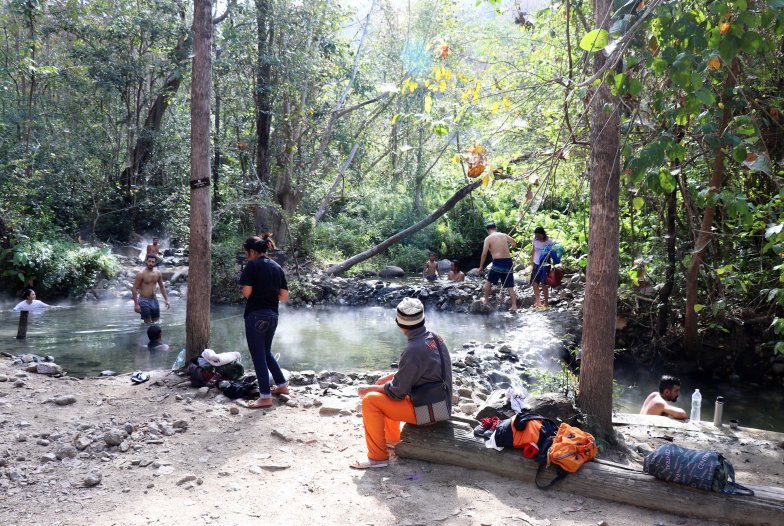
Taking a dip in the warm waters
One pool had a sign indicating that it was 360C but even on a wintry morning it did not feel that warm. There are also private rooms like giant concrete outhouses where families and groups of friends can bathe together – presumably naked as in many Japanese outdoor onsens – but naked bathing is not permitted in Pai’s hot pools.
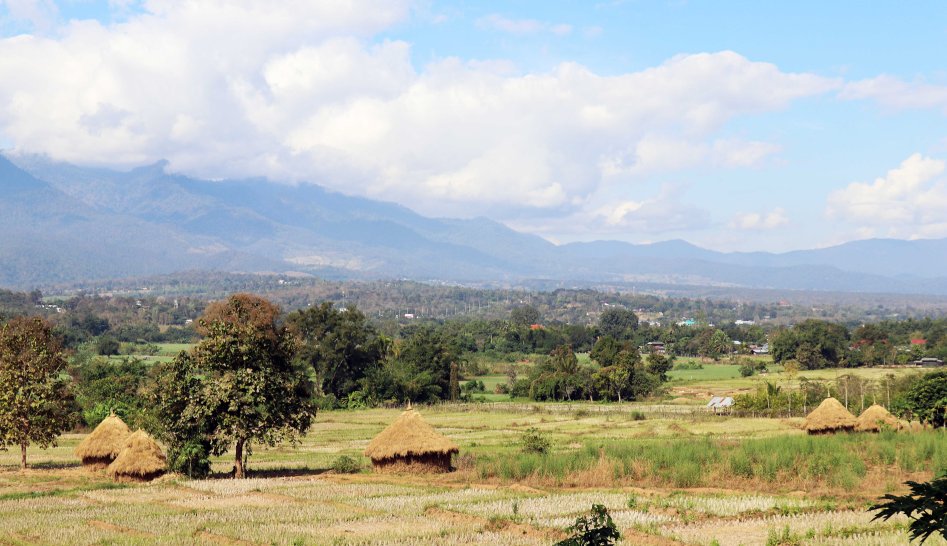
Haystacks and hillsides
Heading back to town, past pretty haystacks in empty fields and the numerous coffee shops, a distant hillside is dominated by a huge white Buddha perched on a terrace 353 steps above the parking lot and the Wat Phra That Mee Yen. The statue was built in t2017 and 2018 and offers excellent views from the top terrace.

Giant Buddha up many steps
Fifty or so kilometres west of Pai – again the journey is up and down and round about, you put your left foot it and shake it all about – you come to the Lod (Spirit) caves known in Thai as Tham Nam Lod which is handy to know if you are trying to read Thai road signs in Thai language as the roads get tighter and narrower and rougher.
Visitors can choose to explore just the first cave (the Big Column cave) or go on to see the other two caves – the Doll Cave and the Coffin Cave. As I do not enjoy claustrophobic spaces I opted for the first one only but then found that with so many other visitors all compulsorily accompanied by guides carrying brightly lit pressure lanterns there was no real feeling of being entombed.
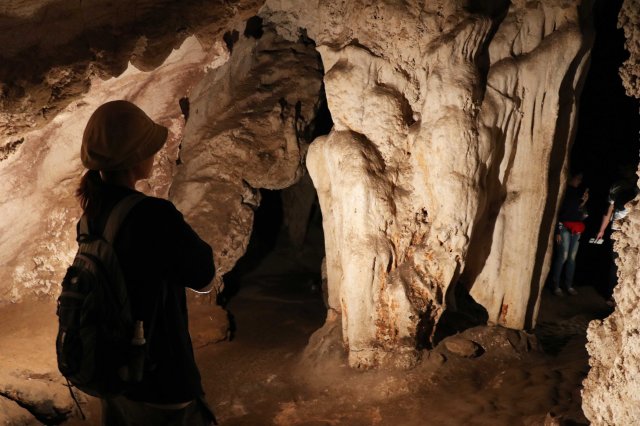
Guide and limestone formation
I then asked my guide to carry on (and paid the additional fees for the additional caves) as I really wanted to see the third cave as it is only accessible by bamboo raft. The limestone formations in the first two caves were quite pretty – all in pure white with no colours – but not particularly spectacular.
Holy Batcave, Batman!
The rafts are powered by ferrymen (see at left) punting away at the prow of incredibly flimsy rickety terrifying things just millimetres above the swarming schools of giant catfish and scores of metres below the hidden – but heard and felt – swarms of bats and birds that populate the third cave.
The handrails up to the ancient timber coffins are covered with bat droppings, as were also my back and head after a short time. Robin and Batman are welcome to their secret hideaway. Unlike the first two caves, this one is a “dead” cave where there is no active growth of stalagmites or stalactites. Just bat droppings.
The return 800-metre ferry ride is uneventful but it was fascinating to see how the ferryman moved from one side of the caves to another and back again – while the flotilla heading downstream just stuck to the centre – and I guessed he was trying to find the route where the current was not so strong.
Massages, tattoos, fisherman’s pants, great street food and great gourmet food, resurrected bridges, public hot baths (no shampoo, please!), crazy tourists on rented motorbikes terrifying locals and visitors alike as they try to negotiate winding roads while watching Google Maps on their telephones, slumbering ferrymen drooped in hammocks draped between trees between river trips, a barking dog or two … and 762 twists and turns: Pai is certainly worth a long-weekend visit.
……………………………………..
Text and photos © Christopher Hall 2019.
Journey 2019
If you enjoyed this story please scroll down to see earlier stories and forward the blog address to your friends: www.hallomega.com
If you would like to receive automatic notification of future postings on this blog please click the FOLLOW button on your screen.
……………………………………..
Great traveller’s log, Chris. Enjoyed it. Trust all goes well with you. News here is that Jane is getting married in a couple of weeks and Jack is heading for the altar about six weeks later. Keep safe and take care – – Darcy T
LikeLike
Thanks Darcy! All best wishes to Jane and Jack!
LikeLike
Another great report Hallomega! Do you publish? Judy
>
LikeLike
Thanks Judy! Publishing is at the back of my mind … perhaps one day …!
LikeLike
I enjoyed sharing in your Pai experience, thanks for writing it
LikeLike
Thanks Lynda – perhaps some of VSP old territory?
LikeLike